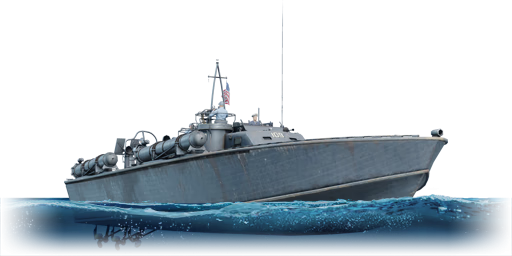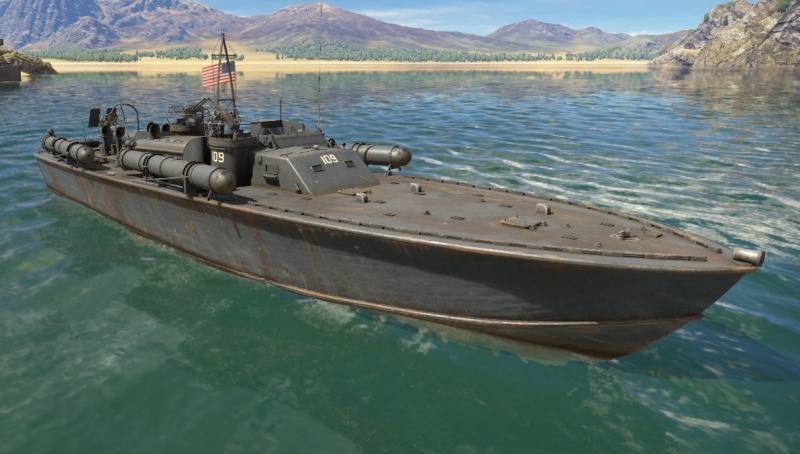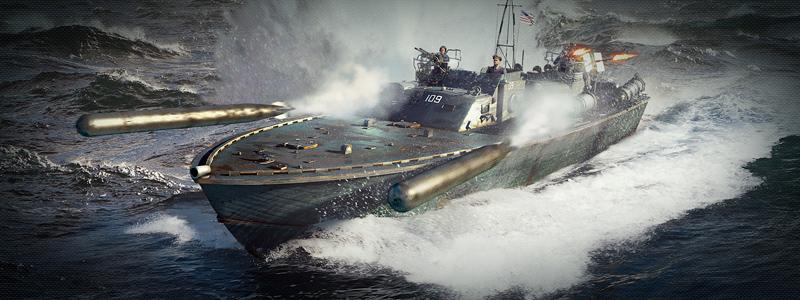PT-109
Contents
Description
The Elco 80 ft PT-109 was perhaps one of the most famous PT boats among the USN torpedo boat fleet as the ship commanded by the would-be 35th POTUS, LTJG John F. Kennedy. The ship was ordered in 1942 as part of the fleet of USN's PT boats built by Elco at Bayonne, NJ and the 7th ship of the PT-103 variant. The ship was delivered to USN on July 1942, then transported to the Pacific battlefield soon in August before it finally joined battle in late December as part of the PT squadron on Tulagi of Solomon Islands by different crews and commander. JFK arrived at the Pacific by February 1943 in against his father, Joseph P. Kennedy Sr.'s will for safer navy positions away from the WWII, helming the boat since 23rd April, 1943, he participated in the night strikes against the Tokyo Express which was the bloodline of IJA/IJN forces at the Solomon Islands; however, after a dreadful action at Blackett Strait with USN PT fleet failed to hit IJN ships at night due to bad coordination on 1st August, 1943, his boat collided with IJN Amagiri at 02:27 on 2nd August and the subsequence explosion killed two of his crews; thanks to JFK's resilient and luck, the remaining eleven crew including himself managed to drift and swam onto the Plum Pudding Island (Now Kennedy Island) before they were rescued by scouts by the 8th August.
PT-109 was one of the earliest pre-orders offered to access the fleet closed beta test before being removed from the store with the wide-release of the closed beta test in Update 1.79 "Project X"; armed with its initial configuration of only twin mount .50 cal and only a Orelikon 20 mm autocannon onboard (the famous 37 mm AT gun was a field modification by the crew in 1943), the overall firepower have some flexibility against both small patrol boats or sometimes armored boats while players should be extra careful for its poor protection to avoid quick demise.
General info
Survivability and armour
The hull structure of the boat has no armour at all. The only armour present on this boat is the bridge that contains 6 mm of antifragmentation armour, and the 13 mm rolled homogeneous armour of the 20 mm mount.
Most of the front hull is open space, and so there are no critical components that could be hit if rounds come in across at the front end. However, from the bridge on backwards is the engine, ammo, torpedoes, and fuel all scattered around that could be easily hit, ignited, or detonated.
Mobility
Powered by 3 Packard W-14 M2500 engines and propelled by 3 propellers, the PT-109 can travel up to 76 km/h; although it is vastly slower than some torpedo attack boat such as G-5 series, the overall mobility can still ensure swift relocations to covers or vantage points to strike enemies.
| Mobility Characteristics | |||
|---|---|---|---|
| Game Mode | Upgrade Status | Maximum Speed (km/h) | |
| Forward | Reverse | ||
| AB | |||
| Upgraded | 106 | 30 | |
| RB/SB | |||
| Upgraded | 76 | 22 | |
Modifications and economy
Armament
Primary armament
Two turrets with twin-mounted AN-M2 machine guns are had around the bridge area. Despite their full-flexible 360 degree traverse, limitations with the boat structure will severely restrict their fire angles against enemy boats.
| 12.7 mm AN-M2 (x4) | ||
|---|---|---|
| Turrets (Bow to stern) | ||
| Front turret (x2) | Rear turret (x2) | |
| Vertical guidance | -7°/+60° | -7°/+60° |
| Horizontal guidance | ±180° | ±180° |
| Ammo capacity (Belt capacity) | 4,000 (200) | |
| Rounds per turret | 2,000 | |
- Universal: API-T · AP · I · AP
- .50 AP belt: API-T · AP · AP · AP
- .50 APIT belt: API-T · API-T · API-T · I
| Penetration statistics | |||||||
|---|---|---|---|---|---|---|---|
| Ammunition | Penetration @ 0° Angle of Attack (mm) | ||||||
| 10 m | 100 m | 500 m | 1,000 m | 1,500 m | 2,000 m | ||
| AP | 29 | 28 | 25 | 20 | 17 | 14 | |
| I | 2 | 2 | 2 | 2 | 2 | 2 | |
| API-T | 28 | 27 | 23 | 19 | 15 | 11 | |
| Shell details | ||||||||||||
|---|---|---|---|---|---|---|---|---|---|---|---|---|
| Ammunition | Velocity (m/s) |
Projectile mass (kg) |
Fuse delay (m) |
Fuse sensitivity (mm) |
Explosive mass (TNT equivalent) (g) |
Ricochet | ||||||
| 0% | 50% | 100% | ||||||||||
| AP | 856 | 0.05 | - | - | - | 47° | 56° | 65° | ||||
| I | 944 | 0.04 | 0.02 | 0.3 | 1.2 | 47° | 56° | 65° | ||||
| API-T | 887 | 0.04 | - | - | - | 47° | 56° | 65° | ||||
Secondary armament
A single 20 mm Oerlikon cannon is mounted at the stern of the boat.
| 20 mm Oerlikon Mk.II | |||||||
|---|---|---|---|---|---|---|---|
| Vertical guidance | -5°/+60° | ||||||
| Horizontal guidance | ±180° | ||||||
| Ammo capacity (Belt capacity) | 420 (60) | ||||||
| Rate of fire (Rounds/min) | 450 | ||||||
- Universal: HEF-T · HEF-I · AP-T
- 20 mm HE: HEF-T · HEF-I · AP-T · HEF-I
- 20 mm AP: AP-T · AP-T · AP-T · HEF-I
| Penetration statistics | |||||||
|---|---|---|---|---|---|---|---|
| Ammunition | Penetration @ 0° Angle of Attack (mm) | ||||||
| 10 m | 100 m | 500 m | 1,000 m | 1,500 m | 2,000 m | ||
| HEF-T | 2 | 2 | 2 | 2 | 2 | 2 | |
| AP-T | 34 | 32 | 24 | 17 | 12 | 8 | |
| HEF-I | 2 | 2 | 2 | 2 | 2 | 2 | |
| Shell details | ||||||||||||
|---|---|---|---|---|---|---|---|---|---|---|---|---|
| Ammunition | Velocity (m/s) |
Projectile mass (kg) |
Fuse delay (m) |
Fuse sensitivity (mm) |
Explosive mass (TNT equivalent) (g) |
Ricochet | ||||||
| 0% | 50% | 100% | ||||||||||
| HEF-T | 830 | 0.12 | 0 | 0.1 | 6.57 | 79° | 80° | 81° | ||||
| AP-T | 830 | 0.12 | - | - | - | 47° | 60° | 65° | ||||
| HEF-I | 830 | 0.12 | 0 | 0.1 | 11.17 | 79° | 80° | 81° | ||||
Additional armament
The PT-109 is armed with four 21 in wet-heating Mk.8 torpedoes, which are mounted with two on the port side and two on the starboard side. Both are angled from the front and so requires angling to get onto target.
| 21 in wet-heating Mk.8 torpedo | ||||||||
|---|---|---|---|---|---|---|---|---|
| # on ship | Mass (kg) | Maximum speed in water (km/h) |
Travel distance (km) | Depth stroke (m) | Arming distance (m) |
Explosive type | Explosive mass (kg) | |
| 4 | 1,252 | 50 | 9.14 | 1.0 | 50 | TNT | 146 | |
Usage in battles
Describe the technique of using this ship, the characteristics of her use in a team and tips on strategy. Abstain from writing an entire guide – don't try to provide a single point of view, but give the reader food for thought. Talk about the most dangerous opponents for this vehicle and provide recommendations on fighting them. If necessary, note the specifics of playing with this vehicle in various modes (AB, RB, SB).
Pros and cons
Pros:
- Slender PT boat profile
- Quite speedy at flank speed
- Open space in front could let some lucky shots pass through harmlessly
Cons:
- Limits in gun traverse means, despite able to traverse 360 degree, there are many angles where only one turret could aim onto target
- Both primary armaments are only able to be used on ship targets at ship starboard side
- Torpedoes at each side are split at an angle, requires manoeuvring to get a decent aim at a target in front
History
Construction
PT-109 was laid down by Elco (Electric Launch Company) in Bayonne, New Jersey, on 4 March 1942. It was launched on 20 June 1942, delivered to the U.S. Navy on 10 July, and completed on 19 July.
Initial Service
Under the command of CDR Henry Farrow, USN, PT-109 was first attached to Motor Torpedo Boat Squadron FIVE (MTBRon5). MTBRon 5 was assigned to the Panama Sea Frontier beginning in September 1942. On 22 September 1942, PT-109 was transferred to MTBRon 2, with her new commanding officer LT George A. Brackett, USNR. MTBRon 2 was transferred to the South Pacific in 1942. There, the squadron took part in the Solomons campaign, fighting night actions against the Japanese Tokyo Express with the goal of defending the US-held Guadalcanal. MTBRon 2 was at Tulagi island on 23 April 1943, when LTJG John F. Kennedy took command of the PT-109.
Media
- Skins
- Images
- Videos
See also
- Elco 80 ft PT-103 - Head of the ship-class that PT-109 was built off.
External links
| Electric Launch Company (Elco) Ships | |
|---|---|
| Patrol Torpedo Boats (PT) | |
| 77' PT | PT-20 · PT-59 |
| 80' PT | PT-103 · PT-109 · PT-174 · PT-314 · Thunderbolt (PT-556) · PT-565 |
| USA boats | |
|---|---|
| Motor torpedo boats | PT-3 · PT-6 · PT-20 · PT-71 · PT-103 · PT-109 · PT-174 |
| PT-200 · PT-314 · Thunderbolt (PT-556) · PT-565 · PT-658 · PT-810 · PT-811 · PT-812 | |
| Motor gun boats | Kim Qui · LCS(L)(3) · PT-59 · PTF-7 · USS Candid · USS Asheville · USS Douglas · USS Flagstaff · USS Tucumcari · USS Cyclone |
| Armoured gun boats | LCM(6) Zippo |
| USA premium ships | |
|---|---|
| Motor torpedo boats | PT-3 · PT-109 · PT-174 · Thunderbolt (PT-556) · PT-658 · PT-811 |
| Motor gun boats | LCM(6) Zippo · USS Douglas · USS Flagstaff |
| Sub-chasers | Carmi (PC-466) |
| Destroyers | USS Welborn C. Wood · USS Wilkinson · USS Bennion · USS Cowell · USS Davis · USS Moffett · USS Phelps · USS Frank Knox |
| Light cruisers | USS Detroit · USS Helena |
| Heavy cruisers | USS Des Moines |
| Battleships | USS Arkansas |






